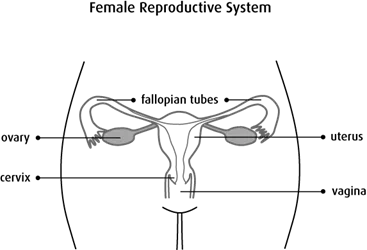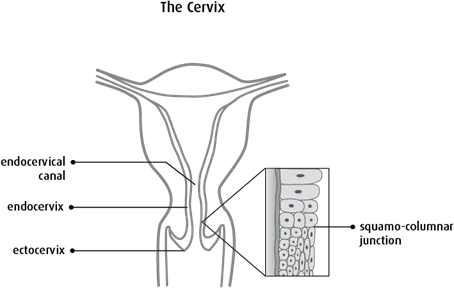The cervix
The cervix is part of the female reproductive system. The female reproductive system is made up of internal organs, including the vagina, uterus, ovaries and fallopian tubes. It is also made up of the external genital organs, including the parts that make up the vulva (the clitoris, vaginal lips and opening to the vagina). All the internal organs are located in the pelvis, which is the lower part of the abdomen between the hip bones.
The cervix is the lower, narrow part of the uterus (womb). The cervix connects the main body of the uterus to the vagina (birth canal).

Structure
The cervix is about 3 to 4 cm long. It is made up mostly of connective tissue and muscle. It is divided into 2 main parts:
- The endocervix is the inner part of the cervix lining the canal leading into the uterus.
- The ectocervix (exocervix) is the outer part of the cervix. It is rounded and lip-like and sticks out into the vagina.
The endocervical canal is the passageway from inside the uterus to the vagina.
These are the 2 main types of cells in the cervix:
- Glandular cells line the endocervical canal. They are tall and shaped like columns and are called columnar cells.
- Squamous cells line the ectocervix and vagina. They are flat and thin like the scales on a fish.
The squamous cells join the columnar cells in an area of the cervix called the squamo-columnar junction. This is also called the transformation zone because the columnar cells are constantly being changed into squamous cells, especially during puberty and child-bearing years. Precancerous changes of the cervix and most cervical cancers start in the transformation zone.

What the cervix does
The cervix connects the body of the uterus to the vagina. Part of the lining of the cervix contains glands that make and release mucus. For most of the menstrual cycle and during pregnancy, the mucus is thick and stops sperm from entering the uterus. The thick mucus also helps to protect the uterus and the upper female reproductive organs from harmful bacteria.
When a mature egg is released from an ovary each month (called ovulation), the mucus changes and becomes thinner. The thinner mucus allows sperm to pass through the cervix into the uterus.
Every month, except during pregnancy or menopause, the lining of the uterus (called the endometrium) is shed through the cervix into the vagina, then out of the body. This process is called menstruation.
During childbirth, the cervix widens (dilates), allowing the baby to pass through the birth canal.
Your trusted source for accurate cancer information
With support from readers like you, we can continue to provide the highest quality cancer information for over 100 types of cancer.
We’re here to ensure easy access to accurate cancer information for you and the millions of people who visit this website every year. But we can’t do it alone.
Every donation helps fund reliable cancer information, compassionate support services and the most promising research. Please give today because every contribution counts. Thank you.
